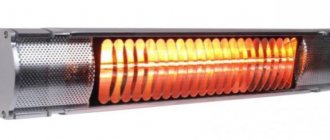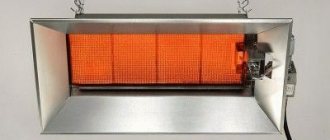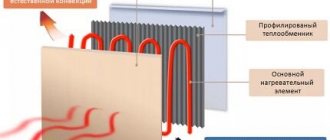Discovery of infrared radiation
Infrared radiation was discovered by astronomer W. Herschel in 1800.
Rice. 1. W. Herschel.
At this time, astronomical instruments had already achieved such high accuracy that the thermal expansion of their parts significantly influenced the measurement results. When observing stars and planets, it is not difficult to ensure a constant temperature, but when studying the Sun, heating of instruments has proven to be a significant problem.
Decomposing sunlight into a spectrum, W. Herschel established that different parts of the spectrum heat matter in different ways: the red part of the spectrum heats much more than the violet part, and the maximum heat generally occurs in the area “beyond visible refraction.”
Subsequently, thanks to the work of T. Jung and O. Fresnel, it was proven that infrared radiation, like light, is electromagnetic radiation.
Harm
In addition to its positive qualities, infrared rays can harm a person. First of all, the mucous membrane of the visual organs suffers, since drying out the fluid leads to a decrease in visual acuity and damage to the cornea.
With high intensity of infrared rays, noticeable and sometimes extensive deep burns remain on the surface of the skin and mucous membranes. Most often, such symptoms, which are expressed in redness of areas of the dermis, increased temperature and other signs, appear in people who, due to their profession, are forced to work under direct infrared radiation.
The mildest form is dermatitis, the most severe diseases from irradiation with infrared radiation are considered to be oncological and benign neoplasms.
Generation of infrared radiation
Infrared radiation, like any other electromagnetic radiation, is generated by oscillating charged particles. In this case, it is the thermal movement of atoms and molecules.
The randomness of the movement determines the continuity of the IR spectrum. It is possible to indicate only the zone of the greatest power of thermal radiation, which corresponds to the most frequently occurring frequency of thermal movements. However, in any heated body there are particles with very different speeds, and therefore the IR spectrum is continuous.
The wavelength corresponding to the maximum radiation of a body heated to absolute temperature $T$ can be found using W. Wien's displacement law. According to it, the wavelength that infrared radiation surfaces emit at maximum power is related to temperature by a simple relationship:
$$\lambda_{max}={2.898×10^{-3}\over T}$$
Where:
- $lambda_{max}$ — wavelength of thermal radiation of maximum power, m;
- $T$ — absolute temperature, K.
The benefits and harms of IR radiation for human health
You can answer the question - is infrared radiation harmful to humans, armed with some information.
Long-wave infrared rays hitting the skin affect nerve receptors, causing a feeling of warmth. Therefore, infrared radiation is also called thermal radiation.
More than 90% of this radiation is absorbed by moisture contained in the upper layers of the skin. It only causes an increase in the temperature of the skin. Medical research has shown that long-wave radiation is not only safe for humans, but also improves immunity and triggers the mechanism of regeneration and healing of many organs and systems. IR rays with a wavelength of 9.6 microns are especially effective in this regard. These circumstances determine the use of infrared radiation in medicine.
A completely different mechanism of action of infrared rays on the human body, which belongs to the short-wave part of the spectrum. They are able to penetrate to a depth of several centimeters, causing heating of internal organs.
At the site of irradiation, due to dilation of the capillaries, redness of the skin may appear, including the formation of blisters. Short IR rays are especially dangerous for the organs of vision. They can provoke the formation of cataracts, disturbances in water-salt balance, and the appearance of seizures.
The cause of the well-known thermal shock effect is short-wave infrared radiation. An increase in brain temperature of 1 °C already causes its symptoms:
- dizziness;
- nausea;
- increased heart rate;
- darkening of the eyes.
Overheating by 2 °C can trigger the development of meningitis.
Now let's understand the concept of intensity of electromagnetic radiation. This factor depends on the distance to the heat source and its temperature. Low-intensity long-wave thermal radiation plays an important role for the development of life on the planet. The human body needs constant replenishment of these wavelengths.
Thus, the harm and benefits of infrared radiation are determined by the wavelength and exposure time.
Properties of infrared radiation
On the electromagnetic wave scale, infrared radiation occupies wavelengths from 1 mm (frequency 300 GHz) to 0.75 μm (frequency 400 THz):
Rice. 2. Electromagnetic radiation scale.
The entire range is conventionally divided into the following subranges:
- Less than 3 microns - near infrared range. The long-wave limit of this range is determined by the deterioration of water transparency for longer waves.
- 3–50 microns - mid-infrared range. This is the range in which most bodies with low temperatures radiate (from –215 to 700 ⁰С).
- Above 50 microns is the far infrared range, extending to microwave radiation on the electromagnetic wave scale.
Despite the fact that all the properties of infrared radiation are practically the same as those of visible light, the optical properties of different substances with respect to infrared radiation differ significantly. For example, dry and clean air is almost transparent to infrared radiation, but the presence of water vapor and carbon dioxide in the air sharply reduces its transparency.
Dust microparticles also affect air transparency, since solids are generally opaque to infrared radiation, although there are exceptions.
For example, ordinary glass transmits near infrared quite well, but blocks far infrared. The greenhouse effect of greenhouses is based on this difference. Solar radiation easily penetrates a glass surface, but the ground emits much longer infrared waves that glass does not transmit.
The properties of infrared radiation determine the areas of its application. First of all, this is a non-contact measurement of body temperature.
Rice. 3. Areas of application of IR radiation.
Ecology DIRECTORY
SOLAR RADIATION (SOLAR RADIATION) - electromagnetic and corpuscular radiation from the Sun. Electromagnetic radiation (radiant energy from the Sun) is electromagnetic waves propagating at a speed of 300 thousand km/s. R.s. reaches the earth's surface in the form of direct and diffuse radiation. About 48% of it falls on the visible part of the spectrum (0.38-0.76 microns), 45% on infrared rays (more than 0.76 microns) and 7% on ultraviolet radiation (less than 0.38 microns). Corpuscular radiation consists mainly of protons moving at a speed of 300-1500 km/s and almost completely captured by the Earth's magnetosphere. R.s. usually measured in SI thermal units - joules (J) per unit time per unit area. [...]
In the infrared region, solar radiation was measured down to wavelengths of 30 microns; here it is greatly weakened by absorption in the earth’s atmosphere (water vapor, CO2 molecules, N02, etc.); in the ultraviolet region (for wavelengths shorter than 2900 A) solar radiation is absorbed by the ozone layer of the earth’s atmosphere. [...]
For the infrared end of the solar radiation spectrum (>0.65 µm) there is also an altitude dependence. For example, Kondratiev (see [64], p. 234), based on the research of S.P. Popov in the USSR, showed that the share of solar infrared radiation in the total incoming radiation increases from 64% near sea level to 83% at an altitude of 2000 m for a constant optical mass of three. A corresponding increase in the infrared component of radiation is also observed at polar latitudes. In both cases, it is the result of less water vapor and, therefore, less radiation attenuation.[...]
ASTRONOMICAL SOLAR CONSTANT. Solar constant in the usual meaning of this term, i.e., determined by also taking into account that solar radiation in the ultraviolet and infrared regions of the spectrum, which is completely absorbed in the high layers of the atmosphere and therefore cannot be extrapolated from ground-based observations. [...]
Electromagnetic radiation in the wavelength range from 0.76 microns to an unspecified upper limit, conventionally up to 500 or 1000 microns. On the one hand, IR borders on visible radiation in the spectrum, on the other hand, it borders or overlaps with ultrashort radio waves. IR is excited primarily by intramolecular processes, in contrast to visible light, which is the result of predominantly intraatomic processes. I.R. rays are refracted less than rays of visible and ultraviolet radiation. In the composition of solar radiation, almost all irradiation occurs at wavelengths from 0.76 to 4 microns, while outside the atmosphere, accounting for almost 50% of the energy of the entire radiation flux. The energy distribution curve in the infrared region of the solar spectrum is close to the spectrum of an absolutely black body at a temperature of 5200°. I.R., in comparison with radiation from other regions of the spectrum, is least scattered in the atmosphere and most absorbed, especially by water vapor. At the earth's surface, the share of radiation in the solar spectrum at high solar altitudes is about 60% of the total radiation flux, and at low altitudes - up to 80%. In this regard, the share of I.R. grows with geographic latitude.[...]
Long-term absorption of solar radiation is not accompanied by progressive accumulation of heat in the earth's surface. The fact is that it itself emits long-wave infrared radiation, invisible to the eye. However, it is not only the earth's surface that emits radiation, but also the atmosphere, heated by radiation and the heat of the earth's surface. The flow of atmospheric radiation directed towards the earth's surface is called counter radiation. Although it is significant, it is less than on earth. The difference between the earth's own radiation and the counter radiation forms the effective radiation.[...]
A. absorbs and scatters solar radiation, itself emits long-wave infrared radiation, absorbs infrared radiation from the earth's surface, and exchanges heat with the earth's surface through thermal conductivity and phase transitions of water. In the atmosphere itself, heat spreads mainly through turbulent exchange, radiation processes and phase transitions of water. Between the underlying surface and the A. there is a continuous water cycle, and in the A. water vapor condenses, fogs and clouds arise, and precipitation can fall from the latter. [...]
V.P. intensively absorbs solar radiation in the red and infrared parts of the spectrum, as well as long-wave radiation (see radiation absorption).[...]
From a physical point of view, solar radiation consists of waves of different lengths. Plants use radiant energy selectively. During photosynthesis, they consume rays with a wavelength of 380 to 740 nm. The region of the solar spectrum used by plants for photosynthesis is called photosynthetically active radiation (PAR). On the side of shorter waves, ultraviolet radiation (UV) is adjacent to the PAR, and infrared (IR) is adjacent to longer waves. [...]
Images in the visible and near infrared (light) range. The visible and near-infrared ranges, including waves with lengths of 0.4-0.75 and 0.75-3 microns, together form the light range. This spectral range, the rays of which are almost completely transmitted by the atmosphere, accounts for almost all the energy of solar radiation (see Fig. 4.6). The sun's rays falling on the earth's surface are reflected differently by it in accordance with the spectral reflectivity of objects. Reflected solar radiation is perceived by the eye, which is sensitive specifically to radiation in the visible range from 0.4 to 0.75 microns; thanks to selective reflection, the color of the observed objects is distinguished.[...]
Greenhouse effect. All types of solar radiation (from ultraviolet to infrared) reach the earth's surface and heat it. The latter re-radiates previously accumulated thermal energy in the form of infrared radiation into space. Re-emitted IR radiation is intensely absorbed by certain gases (CO2, CH4, N0 freons). These gases, called greenhouse gases, act in the atmosphere like glass in a greenhouse: they freely transmit solar radiation to the Earth, but block the Earth's thermal radiation. As a result, the temperature of its surface increases, the weather and climate change.[...]
ABSORPTION BY OZONE. P.O. determines the break in the solar spectrum in the ultraviolet region (see the boundary of the ultraviolet part of the solar spectrum) and the temperature regime of the stratosphere (ozonosphere).[...]
Ozone layers at altitude absorb solar radiation with a wavelength of 290 mmk, protecting living beings from the disastrous effects of short-wave solar radiation. Ozone absorbs about 20% of the Earth's infrared radiation.[...]
Radiant energy of the Sun. The energy of solar radiation propagates in space in the form of electromagnetic waves. In the processes of photosynthesis, the most important role is played by photosynthetically active radiation (380-710 nm).[...]
Airborne measurements of the absorption of infrared solar radiation by methane determine both the integral methane content in the entire atmosphere and the vertical profile of methane concentration. In our country, studies of the total methane content in the atmosphere from an airplane are carried out only at the Main Geophysical Observatory (GGO) named after. A.I. Voeikova on the IL-18 laboratory aircraft. The methodology and some results of aircraft measurements of the integral methane content in the atmosphere are presented in [195]. The authors give a measurement error of 40% for flight altitudes of 5...8 km.[...]
Ozone has several absorption bands in the infrared region of the spectrum, but they are overlapped by more intense bands of carbon dioxide and water vapor. Only a narrow band of 9.4-9.9 µm with a center of 9.65 µm is significant. The absorption of solar radiation by ozone does not exceed 3% of the integral flux.[...]
According to its biological effect, the spectrum of solar radiation is divided into three main regions: the region of ultraviolet radiation; the region of visible radiation occupying a middle position in the solar spectrum; region of infrared radiation.[...]
In Fig. 1X-2 shows the distribution of solar and terrestrial radiation energy outside the earth's atmosphere, as well as the degree of absorption of waves of various lengths by the earth's atmosphere. It can be seen that each component of the atmosphere absorbs solar rays and emits infrared rays.[...]
The source of energy for atmospheric processes is solar radiation. Short-wave radiation reaches the earth's surface, while the Earth, heated in this way, emits energy into the atmosphere and further beyond its boundaries in the form of long-wave (infrared, or thermal) radiation. [...]
Let us add that the temperature of the atmosphere largely depends on the absorption of ultraviolet solar radiation by ozone: the stratospheric air heats up by several tens of degrees, with the maximum heating occurring in the 40-45 km layer at high latitudes in spring and summer. In addition, ozone intensively absorbs infrared (thermal) radiation, especially in the middle of the “transparency window” (8-13 microns), in which water vapor, the main atmospheric absorber and emitter, “does not work.” Therefore, the vertical distribution of atmospheric temperature, and therefore its radiation regime and circulation, directly depend on the behavior of atmospheric ozone. Ozone itself, due to its ability to absorb infrared radiation, is classified as so-called. greenhouse gases that contribute to warming in the troposphere.[...]
Bouguer's law is applicable to the transfer of monochromatic solar radiation in the atmosphere in the spectral range from ultraviolet to infrared radiation inclusive. [...]
Light mode. The amount of radiation reaching the Earth's surface is determined by the geographic latitude of the area, the length of the day, the transparency of the atmosphere and the angle of incidence of the sun's rays. Under different weather conditions, 42 - 70% of the solar constant reaches the Earth's surface (Fig. 4.1). Passing through the atmosphere, solar radiation undergoes a number of changes not only in quantity, but also in composition. Short-wave radiation is absorbed by the ozone shield and oxygen in the air. Infrared rays are absorbed in the atmosphere by water vapor and carbon dioxide. The rest, in the form of direct or diffuse radiation, reaches the Earth's surface (Fig. 5.39).[...]
The photointegrator is calibrated using the actinometric method - according to direct solar radiation, from the spectrum of which a section corresponding to the spectral sensitivity of the sensor is cut out [81. This is a fairly accurate, but at the same time accessible method, unlike the physical one. 14 It does not require special optical equipment. The energy of the required part of the spectrum is measured by a standard actinometer with light filters (13, 15). Its value is determined by the difference in radiation transmitted by a specific light filter of the sensor, i.e. BS-8 or other “cutting” filter, which determines the spectral sensitivity of the device, and an infrared light filter IKS-1 For example, for the wavelength range 380-800 nm, the difference in radiation energy is taken under the BS-8 filters, which mainly transmit radiation with wavelengths greater than 380 nm, and IKS-1, through which long-wave rays pass starting from approximately D. -800 nm. In this case, a correction is introduced for radiation outside the effective transmission length of the filter, as well as for that absorbed by it in the transmission region, taking into account the spectral characteristics of the glass and solar radiation incident on its surface (4). The spectrum of solar radiation is taken according to model calculations for the conditions average optical regime of the atmosphere (1]. Direct rays are separated from scattered ones using a tube with diaphragms, blackened from the inside, designed for a viewing angle of 10°, which is mounted on the sensor and, together with it, is aimed at the Sun through a special mechanism. During its manufacture, carried out according to the recommendations of Yu. D. Yanishevsky, the geometric dimensions of the actinometer tube were taken into account: at the input diaphragm the hole corresponds to the diameter of the sensor window, at the output diaphragm it is twice as large, the length of the tube is 5.72 times the diameter of the window.[...]
The term “greenhouse effect” refers to a specific phenomenon. Solar radiation falling on the Earth is partially absorbed by the surface of land and ocean, and 30% of it is reflected into outer space. A clean atmosphere is transparent to infrared radiation, and an atmosphere containing vapors of triatomic (greenhouse) gases (water, carbon dioxide, sulfur oxides, etc.) absorbs infrared rays, which causes the air to heat up. Therefore, greenhouse gases perform the function of glass coating in conventional garden greenhouses.[...]
It is now possible to directly calculate and map incident radiation from digital topographic data, as shown in Fig. 2.23. A computer calculation model for the components of the energy balance over mountain surfaces has recently been developed [13]. Incoming solar and infrared radiation is calculated for each point, taking into account slope, exposure and horizon occlusion data. Initially, air temperature, humidity and wind speed must be specified at each grid point - these are used to define vertical profiles for calculating heat fluxes. The roughness parameter, albedo and thermal properties of the soil are also set. The model calculates surface temperature, soil heat flux, sensible and latent heat fluxes, and radiation balance, which can then be plotted on a map for specific times of day. The model is based on temperature equilibrium theory, which states that the surface temperature satisfies the energy flow equations for a given set of boundary conditions. Currently, the model is only applicable to clear-sky conditions and has numerous limitations, but it represents a significantly new approach to the study of topoclimate in rugged terrain.[...]
The main difference is the reduction in heat flux per person from solar radiation and the increase in infrared radiation due to cabin enclosures. The latter depends on the temperature 4 degrees. internal surfaces of the cabin and their properties. Thus, it is advisable to choose a temperature of 4 Gy as the second parameter for assessing the effectiveness of the fence. outside of the inner surface. Even more accurately, efficiency can be assessed by the heat flux from the inner surface of the fence to the driver or by the relative decrease in radiation flux to the driver compared to the flux from solar radiation. [...]
Although the effect of a decrease in atmospheric density with height affects the amount of solar radiation, the maximum absorption in the atmospheric column under clear skies is only about 15% of the solar radiation arriving at the upper boundary of the atmosphere. Infrared radiation fluxes are strongly influenced by the increasing transparency of the atmosphere at high altitudes and lower air temperatures. [...]
Correction for absorption in spectrobolometer optics, introduced into the results of calculating the solar constant. Determined using a spectrograph with a salt prism that transmits infrared radiation up to 10.9 microns. IP is about 2% of the intensity of the integral flux of solar radiation. [...]
Rays with X = 380 ... 710 nm are of primary importance for photosynthesis. Long-wave (far-infrared) solar radiation (X > 4000 nm) has little effect on the vital processes of organisms. [...]
The visible part of the light in the atmosphere is scattered by air molecules and aerosols more strongly than the invisible, infrared part. As the height of the Sun above the horizon decreases in the energy illumination by direct solar radiation, the visible part of the spectrum decreases faster than the infrared, and the light equivalent decreases.[...]
This is primarily due to the high moisture content of the near-equatorial atmosphere, strong absorption of infrared radiation in the spectrum of direct solar radiation with predominant scattering by aerosols compared to temperate latitudes. The source of aerosols in the tropical latitudes of the North Atlantic are the arid regions of Africa. The northern trade winds of the Atlantic Ocean carry large amounts of continental aerosols and water vapor into its waters. Thus, according to radiothermal sounding data at ATEP from the R/V Akademik Kurchatov, the mass of water vapor in the vertical column of the atmosphere reached 50-60 kg/m2. In temperate latitudes it is 2 times less.[...]
The life activity of all living organisms, including humans, is work that requires energy. The energy of solar radiation is primary on Earth and is of primary importance for life in the infrared (0.75-4 microns) and ultraviolet (0.28-0.4 microns) regions of the spectrum.[...]
This can be explained by the fact that the molecular dissipation of energy illumination by direct solar radiation in the visible part, according to Rayleigh's law, is much more intense than in the infrared part of the spectrum. In addition, the visible part of the spectrum is exposed to aerosol scattering to a greater extent than the infrared. In the visible part of the spectrum there is practically no absorption of radiation by water vapor and the coefficient of translucency of the atmosphere is a characteristic of its aerosol opacification.[...]
In addition, ozone, being in the form of a layer of the Earth's atmosphere - the ozonosphere, has extremely important biological significance. This layer protects living organisms on Earth from the harmful effects of short-wave ultraviolet radiation from the Sun. Ozone plays a significant role in creating the thermal regimes of various layers of the atmosphere due to the strong absorption of solar radiation and terrestrial radiation. Ozone absorbs ultraviolet and infrared rays most intensely. Solar rays with a wavelength of less than 300 km are almost completely absorbed by atmospheric ozone. Thus, the Earth is surrounded by a kind of “ozone screen” that protects many organisms from the harmful effects of ultraviolet radiation from the Sun.[...]
Systematic observations of carbon dioxide content in the atmosphere show its increase over the past ten years. Meanwhile, it is well known that carbon dioxide acts in the atmosphere like glass in a greenhouse: it transmits solar radiation and does not transmit back the infrared (thermal) radiation of the Earth and thereby creates the so-called greenhouse effect. [...]
Sea water is a translucent medium, so the light flux penetrating into the water is weakened due to selective absorption and scattering. Light attenuation occurs differently in the short-wave and long-wave regions of the solar spectrum. Long-wave radiation - infrared, red and orange rays - is intensively absorbed by a thin surface layer, and blue, violet and ultraviolet rays, effectively scattering, penetrate to a considerable depth. Thus, the intensity of infrared rays passing through a meter-thick layer of water weakens by 2.7 times, while blue rays, when passing through the same layer of water, lose only 7 e of their energy. [...]
The primary source of energy for ecosystems is the Sun. The energy flow (according to T.A. Akimova, V.V. Khaskin, 1994) sent by the sun to planet Earth exceeds 20 million. Due to the sphericity of the earth, only a quarter of this flow approaches the boundary of the entire atmosphere. Of this, about 70% is reflected, absorbed by the atmosphere, and emitted in the form of long-wave infrared radiation. The solar radiation falling on the Earth's surface is 1.54 million. This huge amount of energy is 5000 times greater than the entire energy of humanity at the end of the 20th century and 5.5 times the energy of all available fossil fuel resources of organic origin, accumulated over at least 100 years. million years.[...]
The surface layer of the troposphere is most affected by anthropogenic impact, the main type of which is chemical and thermal air pollution. Air temperature is most strongly influenced by the urbanization of the territory. Temperature differences between an urbanized area and the surrounding undeveloped areas are associated with the size of the city, building density, and synoptic conditions. There is a rising trend in temperature in every small and large city. For large cities in the temperate zone, the temperature contrast between the city and the suburbs is 1-3° C. In cities, the albedo of the underlying surface (the ratio of reflected radiation to total radiation) decreases as a result of the appearance of buildings, structures, and artificial surfaces; here solar radiation is more intensively absorbed and accumulated by structures buildings absorb heat during the day with its release into the atmosphere in the evening and at night. The heat consumption for evaporation is reduced, since the areas with open soil cover occupied by green spaces are reduced, and the rapid removal of precipitation by rainwater drainage systems does not allow the creation of moisture reserves in soils and surface water bodies. Urban development leads to the formation of zones of air stagnation, which leads to its overheating; the transparency of the air in the city also changes due to the increased content of impurities in it from industrial enterprises and transport. In the city, the total solar radiation decreases, as well as counter infrared radiation from the earth’s surface, which, together with the heat transfer of buildings, leads to the appearance of a local “greenhouse effect”, i.e. the city is “covered” with a blanket of greenhouse gases and aerosol particles. Under the influence of urban development, the amount of precipitation changes. The main factor for this is a radical reduction in the permeability of the underlying surface to sediments and the creation of networks to drain surface runoff from the city. The huge amount of hydrocarbon fuel burned is of great importance. On the territory of the city in warm times there is a decrease in absolute humidity values and the opposite picture in cold times - within the city the humidity is higher than outside the city.[...]
Application
Infrared radiation is used in various fields of technology and everyday life. The most striking examples that every person has encountered in their life will be listed below.
Solarium
Lamps with ultraviolet spectrum type A and B are mainly used in such booths, however
Recently, full-spectrum devices have begun to be produced that also use infrared radiation.
Such devices serve for uniform tanning and overall strengthening of the body, since UV rays stimulate the production of vitamin D in the body, and infrared rays strengthen the immune system and promote cell regeneration.
Flashlight
Such devices are most often used for narrowly targeted human activities, namely moving through a forest or territory without being visible to surrounding animals and people. Similar products are installed as illumination for optical sights, which are used by those who like to hunt at night.
Spotlight
If video surveillance in a private or other protected area during the day does not cause any special problems with installation and picture quality, then at night it is impossible to achieve a similar effect without special devices.
Then special IR spotlights are installed, the light from which is not visible, but as a result of signal transformation in the cameras and video processing, an excellent image is obtained no worse than the daytime version.
Laser
Such products can be used in a wide range of human activities, but lasers have become the most popular in medicine. Thanks to the high power due to the concentration of infrared rays in a narrow beam, the most effective and strong targeted effect on the affected area of the body is achieved.
Heating and heating
Many people use heaters that are equipped with infrared lamps. Such devices are characterized by higher efficiency and efficiency than their oil and air counterparts. Moreover, regardless of the presence of a draft or other microclimatic influences in the room that affect the uniformity of heating, no such problems are observed with infrared devices.
Dryers for car service
IR radiation is harmless for all car materials and does not lead to fading of the main shade or destruction of the structure. At the same time, surface drying and uniform paint coating are quickly achieved.
Food Sterilization
Many foods contain beneficial and harmful bacteria that can grow in them. To prevent the consumer from receiving poisoned and toxic products, they must be sterilized using infrared emitters. As a result of such treatment, harmful bacteria cease their vital activity and will not multiply. Therefore, food is stored longer and remains fresh.
Cooking food
Many housewives have been using microwave, induction and electric ovens and stoves for a long time. As a result of heating from infrared radiation of food, the cooking process is accelerated and is characterized by more uniform heating throughout the entire volume of food.
Night-vision device
Such products are rarely used, namely in special industries, where it is necessary to perform certain tasks and work in places without proper lighting.
This device is based on the use of germanium crystals, which convert infrared rays into visible green rays.
Many have encountered similar pictures in various programs and can imagine exactly how living and heat-emitting objects are reflected on the device screen.
Mattress
Use for heating in domestic conditions can significantly reduce the cost of heating premises. This is very important in the case of huge rooms that are not fully used during the cold period. Thus, a person receives a warm bed and reliable heating of the rooms used.
Thermography
This type of study is used to diagnose various diseases that cannot be diagnosed by other methods. A prime example is breast thermography, which shows the distribution of heat in the muscle and connective tissues.
Homing
Most modern missiles and weapons use homing systems. This is done to ensure that the missile, regardless of course, always hits the target according to its thermal signature. Similar technologies are used in aviation to protect territories from enemy penetration by states.
Spectroscopy
You can learn about the qualities, molecular and atomic composition of a substance using infrared spectroscopy. By receiving radiation from a body in certain spectral bands in the IR spectrum, which are characteristic of individual atoms, molecules or ions, using such diagnostics, the qualitative and quantitative composition of any body, liquid or gas is determined.











